 Come August, we will be heading to photograph the sandstone cliffs, village life, well-known rock cut temples and small temples in leafy places in and around the beautiful small town of Badami. Join us on the photography tour to Badami. Also visit Darter facebook page to stay updated on our tour schedules and new announcements.
Come August, we will be heading to photograph the sandstone cliffs, village life, well-known rock cut temples and small temples in leafy places in and around the beautiful small town of Badami. Join us on the photography tour to Badami. Also visit Darter facebook page to stay updated on our tour schedules and new announcements.
Introduction
Badami is known for its rock cut temples and a history dating back more than thousand years. Travel photographers see much more than just that; this small town offers a wide variety of photography opportunities. There are red sandstones glistening in the morning sun, waterfalls that come alive and tumble down the cliffs adjacent to the caves in the monsoon months, colonies of friendly people with photogenic face who are more than happy to be subjects for your camera, a rural life where you see women washing clothes in a lake next to men scrubbing a bullock’s hide, temples in leafy environs with roots of ficus trees drooping over the gopuras, brilliant landscapes of cliffs overlooking a lake,.. The list is very long.
Darter Photography takes you to this Badami and nearby places that are a mix of well-known and unknown, bringing you great photography opportunities that can keep your clicking finger busy.
Our photography experts with in-depth experience of photographing Badami’s surroundings will work with you through some class-room sessions and all through the outdoor shoots to ensure that you get the best images.
Go to photography tour of Badami to see more details and to register.
This post has travel information on Badami. See earlier posts in the series for travelogue on Badami
Badami is a small town in North Karnataka, about 500km from Bangalore. It is known for the remains of Chalukya dynasty, whose kings ruled a large part of Indian peninsula between Narmada and Kaveri between 6th and 8th century. Particularly well known are the cave temples – four temples that are cut from sandstone rocks. But there is much more to Badami.
Also well known is the group of temples in nearby Pattadakal, a UNESCO world heritage site. Aihole, another site of ancient temples and once a capital of Chalukyas is about 45km from Badami.
History and Legend
The Chalukya kings chose Badami as their capital in 6th century AD. Most of the ancient structures seen in Badami today are attributed to Chalukyas. The fort walls on the cliff above the caves temples is attributed to Tipu Sultan. Pallava King Narasimhavarman I conquered Badami for a brief period, but it was recaptured by the Chalukyas. Rashtrakutas ruled Badami from 8th century. The later Chalukyas, also called Kalyani Chalukyas or Western Chalukyas conquered Badami from Rashtrakutas in 11th centurey AD. In later years, Badami was ruled by Vijayanagar Kings, Adil Shahis of Bijapur, Marathas, Tipu Sultan and the British.
According to legends, Sage Agastya was invited by demon Ilvala for a meal during his journey south of Vindhyas. Ilvala and his brother Vatapi called guests home and killed them in the most innovative possible way. Vatapi would turn into a ram while Ilvala would cook the ram’s meat and offer it to the guests. Once eaten, Vatapi would come out splitting the stomach of the guest, thus killing him. Badami is said to be the place where the event occurred. Two rock faces around Agastya Lake are said to be the bodies of slain demons.
Places to Visit
Cave Temples. Cave Temples are the most popular structures in Badami. A bulk of tourists who arrive in town simply visit these temples and go back. There are four such temples – three of them dedicated to Vedic Gods and the fourth one being Jain. Cave III is the largest and most elaborate of all these temple. All the caves have an array of square pillars and a simple sanctum inside, without a provision for circumambulation. The most elaborate of the statues in each cave are located at the walls on either side immediately after entering. Some of the attractive carvings include the statue of Nataraja in Cave I, Varaha and Vamana in Cave II and Vishnu in the third. The fourth temple has a series of carvings of the Jain Tirthankaras.
Beware of unruly monkeys while you are at the caves. They often snatch handbags and other things from tourists, even cameras.
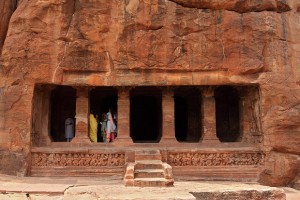
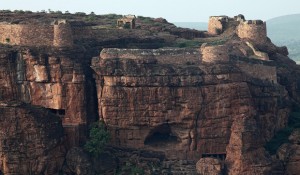
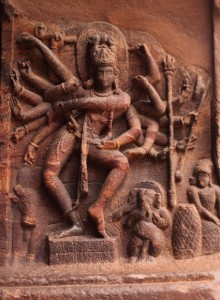
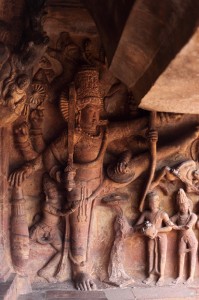
Agastya Lake, Bhoothanatha Temple and ASI Museum. The large tank facing the caves of Badami is called Agastya Lake. The lake once had boating facilities, but it has been stopped in recent past. Bhoothanatha Temple is a vesara style temple located at the edge of the lake on the northern side. The temple is in a dramatic setting with tall sandstone hills surrounding it in 3 sides and the lake on the fourth. East of Bhoothanatha Temple is a small cave, inside which you can see a statue of Buddha, now broken.
An ASI museum is located at the northern side of the lake. The museum has a collection of statues and a small model of Sidlaphadi, a rock bridge located at about 4km from Badami.
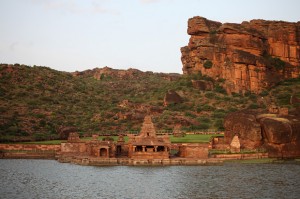
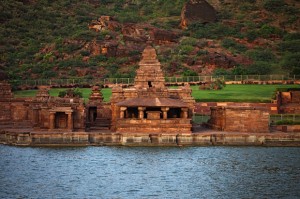
Sandstone Rocks and fissures. Agastya Lake is surrounded by hills made of sandstone rocks. Parts of these rocks have interesting gaps that serve as pathways to go up the hill. It is an interesting experience walking through these narrow gaps amidst tall, reddish sandstone rocks. Take the steps leading up from the ASI museum.
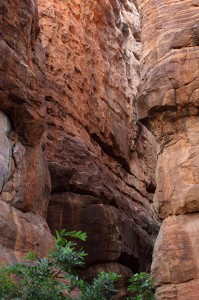
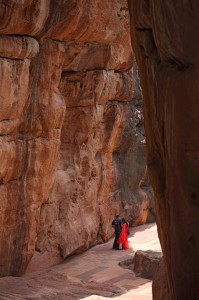
Sidlaphadi. Sidlaphadi is a rock bridge of sorts – a horizontal stretch of rock supported on both sides with a wide gap in the middle. ASI has found evidences of this place being a shelter to prehistoric man. Sidlaphadi is about an hour’s walk from the cave temples. Since there is no clear path, it is necessary to hire a guide to get there.
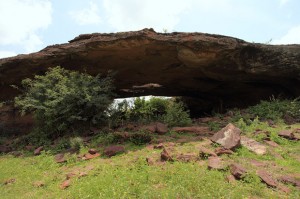
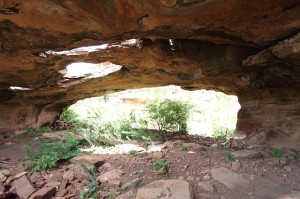
Nearby Places
Aihole. The village of Aihole is often called ‘The Cradle of Indian Architecture’ since it once hosted an architectural school. All around Aihole, you can see Vedic, Buddhist and Jain temples in various shapes and sizes dating to as far back as 6th century. Aihole is about 45km from Badami. Read more about Aihole.
Pattadakal. The group of temples in Pattadakal on the bank of Malaprabha River are declared as a UNESCO World Heritage Site. Pattadakal is about 20km from Badami. Read more about Pattadakal.
Mahakoota. A large temple in the quiet village of Mahakoota dates back to the time of Chalukya Kings. It has a distinct structure that isolates itself in size and architecture from other Chalukyan temples. The temple is characterized by large ficus trees surrounding it. A perennial spring feeds a tank in the temple premises. Visitors are free to take a dip and bathe in the tank. Mahakoota is about 15km from Badami. Read more about Mahakoota.
Banashankari. The ancient temple is Banashankari, 5km from Badami, is now a popular pilgrim center. It is more known for its annual fair which attracts large crowds. Read more about Banashankari.
Other places and things to do
Although Mahakoota is accessible by road, you can walk from Badami through the table land formed by the sandstone hills. The walk takes you through some interesting sandstone structures, shrub jungles and fields. There is no clearly demarcated path, so hiring a guide is advisable. It should take anywhere between one to two hours to get to Mahakoota. Start early in the day to avoid the blazing afternoon sun. Carry plenty of water. At the end of the walk, jump into the tank in Mahakoota Temple and rejoice in the clean spring water for as long as you like.
Naganathakolla is a village with a small temple from Chalukyan times. It is in a forested area and is usually void of people. It is located on the road from Banashankari to Mahakoota. If you come here by public transport, you may have to walk into the forest for about a kilometer.
Local transport
The monuments of Badami are within walking distance and about a kilometer away from the bus stand. You can hire a tonga or auto-rickshaw if you wish, but it should be easy to walk from bus stand. Banashankari is well connected by buses. Buses to Pattadakal and Aihole are not very frequent, so get the bus schedule and plan it properly if you intend to use public transport. Smaller private vehicles(Mahindra Matador) also ply to Pattadakal from Badami. Shared autos and infrequent buses are available to go to Mahakoota.
If you would like to be on your own, you can hire an auto-rickshaw or a cab at Badami.
How to reach.
Badami is about 500km from Bangalore, it is an overnight journey in a KSRTC bus. It is a long distance if you intend to drive, so reserve more than a weekend for a driving trip. Badami has a train station, but just has a few local trains arriving here. The nearest well connected stations are in Gadag and Hubli. If you are coming from far, fly into Bangalore airport. Kingfisher Red flies to Hubli from Bangalore and Mumbai. Browse map of Badami and driving directions from Bangalore below.
View Driving directions from Bangalore to Badami in a larger map
How much time?
A lot of people visit all of Badami, Aihole and Pattadakal in just one day. It works good if you are coming from elsewhere and planning to go to another places to stay for the night, and you want to visit only those sites popular with tourists. But to explore well, give a full day for Aihole, half day for Pattadakal and two days to Badami. Give another half day for Mahakoota. If you would like to explore the rocky terrain of Badami, the more time you have the merrier.
Where to stay
People who make a day-trip to Badami, Aihole and Pattadakal tend to stay in faraway Hospet or Bijapur. Badami has just one mid-range hotel – Badami Court. Near the bus stand are a few budget hotels where you can get clean rooms. Inspect the rooms before checking in. Accommodation is hard to come by in Pattadakal and Aihole. It is recommended to stay in Badami and visit these places.
End of Series.
Women yapping in the veranda, giggling children asking to be photographed and solemn men in the courtyards of public building staring into infinity to brood on world changing events together characterize bulk of Badami’s population. I wrote about them in bits and pieces in earlier posts. Here is putting them together in one post.
Most of the houses have some women or children sitting outside and killing time. When I heard two such kids pleading for a photo, I was glad to oblige and pulled out the camera from the bag. The next was the turn of an old lady, who was equally eager as the kids. She was with a group of 3-4 women on the veranda who had spread some grains around them for cleaning. She laughed jovially and asked to be photographed. I was happy to oblige again. There was a bit of excitement among the ladies when I took out the camera. They barely spoke first, but got chatty as soon as they realized that I speak Kannada. In these parts, they still think you are from a faraway country if you are hanging out with a backpack and a camera.
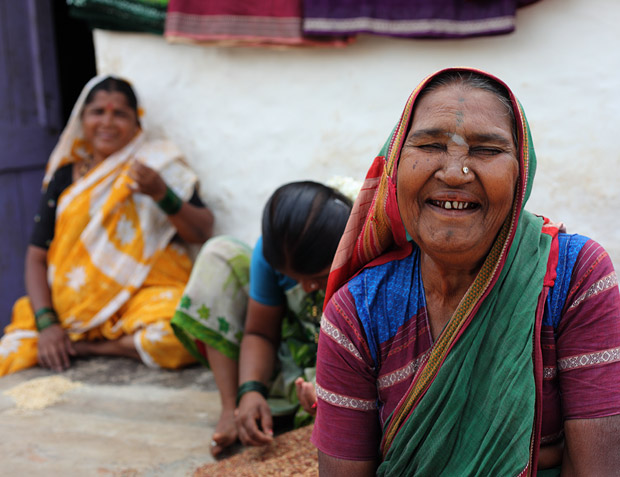
If I remember correctly, the lady’s name is Eeravva. She tried to pose and became stiff when I pointed the camera at her. I pulled back, smiled at her and said ‘you are supposed to smile’. The women around laughed, and Eeravva joined them too and said ‘I have a very big mouth’, indicating that she may not look very good smiling. The ice broken, I took a few pictures as she smiled. I was invited for tea soon after the photo session, but I politely declined. The conversation that ensued between us on the street was very typical – I was asked about my whereabouts, my family and what do I do for a living. Eeravva blurbed her story and about her children, unasked. I was invited for lunch that afternoon before I continued further towards the lake.
In Badami, women tend to sit together in front of the house, do some work and yap with their neighbours. Kids, restless that they are, keep going back and forth on the narrow streets, more often than not in their school uniforms. The younger men go out of the house to work. Old men have a difficulty in spending time. They gather under the ficus tree, in front of the temple, or wherever there is some space to sit. They discuss about world changing events, gaze at people walking on the street, try to strike conversation with anyone and everyone, play something silly, gamble or just continue to stay bored.
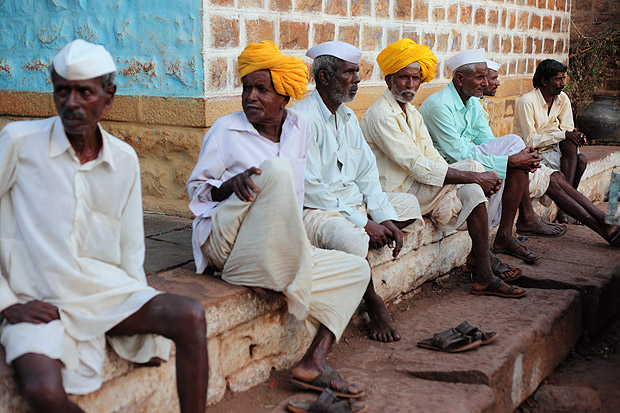
One evening I spent time taking pictures of a few of them, and naturally a conversation or two followed. Somehow the first question that pops up in everyone’s mind is “where are you from?” Subsequent questions can vary, but still belong to a small predictable set. ‘What do you do?’, ‘Are you a tourist?’, ‘Can you speak Kannada?’, etc.
Children hardly differ from one tourist town to other. ‘One photo,’ is a popular phrase with Badami’s kids too. They are delighted to see a stranger with a backpack. They come running, raise the index finger and repeat those well worn words with great delight. When I get one such request, I smile at them and move on if I am in a hurry to get somewhere. But when I have time in my hands, I pause for a quick chatter, take a picture and show it to them. It makes then dance with delight and makes me feel good. But I have to move on before their friends, and friends’ friends come along and build an army around me.
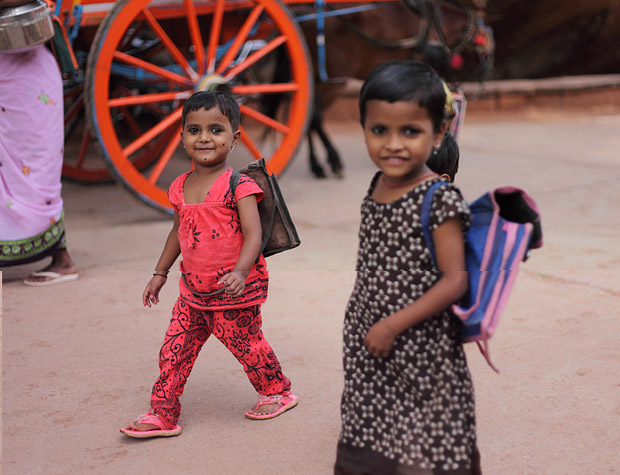
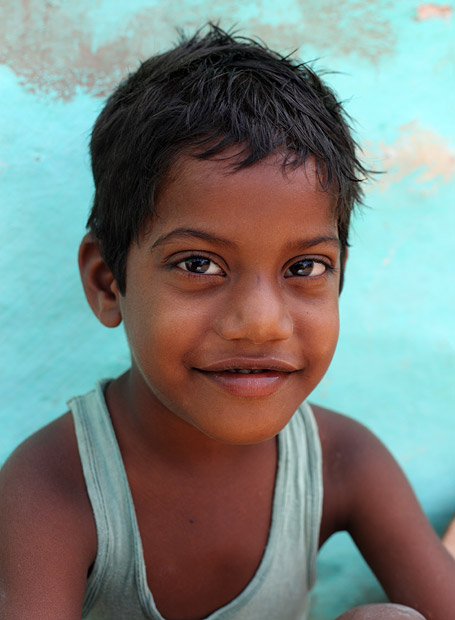
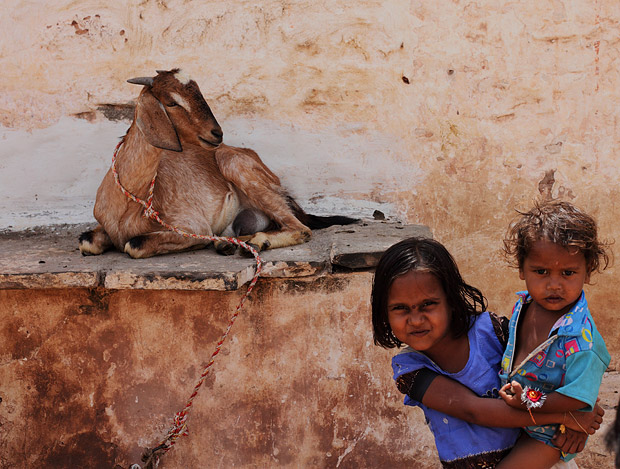
 Come August, we will be heading to photograph the sandstone cliffs, village life, well-known rock cut temples and small temples in leafy places in and around the beautiful small town of Badami. Join us on the photography tour to Badami. Also visit Darter facebook page to stay updated on our tour schedules and new announcements.
Come August, we will be heading to photograph the sandstone cliffs, village life, well-known rock cut temples and small temples in leafy places in and around the beautiful small town of Badami. Join us on the photography tour to Badami. Also visit Darter facebook page to stay updated on our tour schedules and new announcements.













